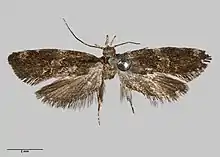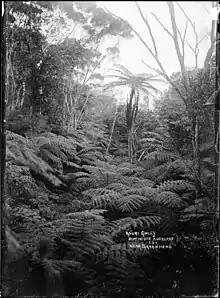| Trachypepla nimbosa | |
|---|---|
 | |
| Male holotype | |
| Scientific classification | |
| Domain: | Eukaryota |
| Kingdom: | Animalia |
| Phylum: | Arthropoda |
| Class: | Insecta |
| Order: | Lepidoptera |
| Family: | Oecophoridae |
| Genus: | Trachypepla |
| Species: | T. nimbosa |
| Binomial name | |
| Trachypepla nimbosa | |
Trachypepla nimbosa is a species of moth in the family Oecophoridae. It is endemic to New Zealand. This species has been collected in Auckland as well as one specimen in the West Coast. Adults are on the wing in January however the West Coast specimen was collected in November. This species is classified as "Data Deficient" by the Department of Conservation.
Taxonomy
This species was described by Alfred Philpott in 1930 using a male specimen collected by Charles E. Clarke at Kauri Gully, Birkenhead on 13 January 1919.[2][3] George Hudson discussed and illustrated this species in his 1939 book A supplement to the butterflies and moths of New Zealand.[4] The holotype specimen is held at the Auckland War Memorial Museum.[3]
Description
.jpg.webp)
Philpott described this species as follows:
♂︎, 12 mm. Head and thorax purplish fuscous ; face mixed with ochreous. Palpi bright ochreous mixed with blackish, apex of terminal segment black. Antennae fuscous annulated with ochreous, ciliations in ♂︎2. Abdomen light purplish fuscous. Legs greyish fuscous mixed with ochreous, tarsi annulated with bright ochreous. Forewings elongate, costa moderately arched, apex rounded, termen rounded, oblique ; dark fuscous with some whitish ochreous admixture ; scale-tufts blackish tipped with ochreous (a basal one and plical and first discal spots) ; an obscure costa before apex : fringes concolorous with wing, but with faint darker basal line. Hindwings dark brownish fuscous : fringes dark fuscous with darker basal line.[2]
Distribution

This species is endemic to New Zealand.[1][5] This species has been collected at the type locality of Kauri Gully as well as at other locations in Auckland and once on the West Coast.[6][7]
Biology and behaviour
The adults of this species are on the wing in November and January.[4][7]
Conservation status
This species has been classified as having the "Data Deficient" conservation status under the New Zealand Threat Classification System.[8]
References
- 1 2 "Trachypepla nimbosa Philpott, 1930". www.nzor.org.nz. Landcare Research New Zealand Ltd. Retrieved 2018-06-04.
- 1 2 Philpott, Alfred (1930). "New species of Lepidoptera in the collection of the Auckland Museum". Records of the Auckland Institute and Museum. 1: 1–16.
- 1 2 Dugdale, J. S. (1988). "Lepidoptera - annotated catalogue, and keys to family-group taxa" (PDF). Fauna of New Zealand. 14: 1–269. ISBN 0477025188. Archived from the original (PDF) on 22 July 2019. Retrieved 4 June 2018.
- 1 2 Hudson, G. V. (1939). A supplement to the butterflies and moths of New Zealand. Wellington: Ferguson & Osborn Ltd. pp. 449–450. OCLC 221041540. Retrieved 4 June 2018.
- ↑ Gordon, Dennis P., ed. (2010). New Zealand inventory of biodiversity: Kingdom animalia : chaetognatha, ecdysozoa, ichnofossils. Vol. 2. p. 462. ISBN 978-1-877257-93-3. OCLC 973607714. OL 25288394M. Wikidata Q45922947.
- ↑ "NZTCS Lepidoptera Spreadsheet". www.doc.govt.nz. Retrieved 4 June 2018.
- 1 2 "Trachypepla nimbosa Philpott, 1930". www.gbif.org. Retrieved 2022-07-29.
- ↑ Hoare, R.J.B.; Dugdale, J.S.; Edwards, E.D.; Gibbs, G.W.; Patrick, B.H.; Hitchmough, R.A.; Rolfe, J.R. (2017). "Conservation status of New Zealand butterflies and moths (Lepidoptera), 2015" (PDF). New Zealand Threat Classification Series. 20: 5.